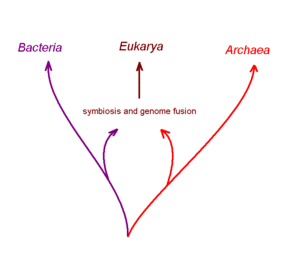Evolution of cells
- See also: Eukaryotes, Archaea, Bacteria
"The evolution of modern cells is arguably the most challenging and important problem the field of Biology has ever faced. In Darwin's day the problem could hardly be imagined. For much of the 20th century it was intractable. In any case, the problem lay buried in the catch-all rubric "origin of life"---where, because it is a biological not a (bio)chemical problem, it was effectively ignored. Scientific interest in cellular evolution started to pick up once the universal phylogenetic tree, the framework within which the problem had to be addressed, was determined (refs. 3 and 4; Fig. 1). But it was not until microbial genomics arrived on the scene that biologists could actually do much about the problem of cellular evolution." (Carl Woese, 2002) [1]
The common ancestor of eukaryotes, bacteria, and archaea may have been a community of organisms. It would have contained:
- Autotrophs that produced organic compounds from CO2 either photosynthetically or by inorganic chemical reactions;
- Heterotrophs that obtained organics by leakage from other organisms;
- Saprotrophs that absorbed nutrients from decaying organisms; and phagotrophs that were sufficiently complex to envelop and digest prey.
How the current lineages of microbes evolved from this postulated community is currently unsoved but subject to intense research by biologists, stimulated by the great flow of new discoveries emerging from genome science.[2]

The challenges of acertaining an accurate branching structure for evolutionary trees of microbes, near a postulated root to the tree of life, have been a great spur for current biological research, but clear answers to important questions about this root-stock of living thing are not yet available.
Instead of relying a single gene such as the SSU rRNA gene to reconstruct early evolution, or a few genes, scientific effort has shifted to exploiting the comprehensive information from the many complete genome sequences of organisms that are now available.Cite error: Closing </ref> missing for <ref> tag
One controversial hypothesis coming out of recent computer-assisted studies of complete genome DNA sequences is that the first nucleated cell arose from two distinctly different ancient prokaryotic (non-nucleated) species that had formed a symbiotic relationship with one-another to carry out different aspects of metablism. One partner of this postulated symbiosis is proposed to be a true bacterial cell, and the other an archaean cell. It is postulated that this symbiotic partnership progressed via the cellular fusion of the partners to generate a chimeric or hybrid cell with a membrane bound internal structure that was the forerunner of the nucleus. The next stage in this scheme was transfer of both partner genomes into the nucleus and their fusion with one-another. Several variations of this hypothesis for the origin of nucleated cells have been suggested[3],
But some biologists dispute this conception .[4] argue for the need for a shift in conceptual framework if this problem is to be solved - and point out that early living communities would compise many different entities and shore their genetic material more exptensively than curret microbes.[5]
References
Citations
- ↑ Woese C (2002) On the evolution of cells. Proc Natl Acad Sci USA 99:8742-7 PMID 12077305 This article shifts the emphasis in early phylogenic adaptation from vertical to horizontal gene transfer. (Open access.)
- ↑ Kurland CG et al. (2006) Genomics and the irreducible nature of eukaryote cells. Science 312(5776):1011-4 PMID 16709776
- ↑ Esser C et al. (2004) A genome phylogeny for mitochondria among alpha-proteobacteria and a preedominantly eubacterial ancestry of yeast nuclear genes. Mol Biol Evol 21:1643-50 PMID 15155797
- ↑ Kurland CG et al. (2006) Genomics and the irreducible nature of eukaryote cells. Science 312(5776):1011-4 PMID 16709776
- ↑ Woese C (2002) On the evolution of cells. Proc Natl Acad Sci USA 99:8742-7 PMID 12077305